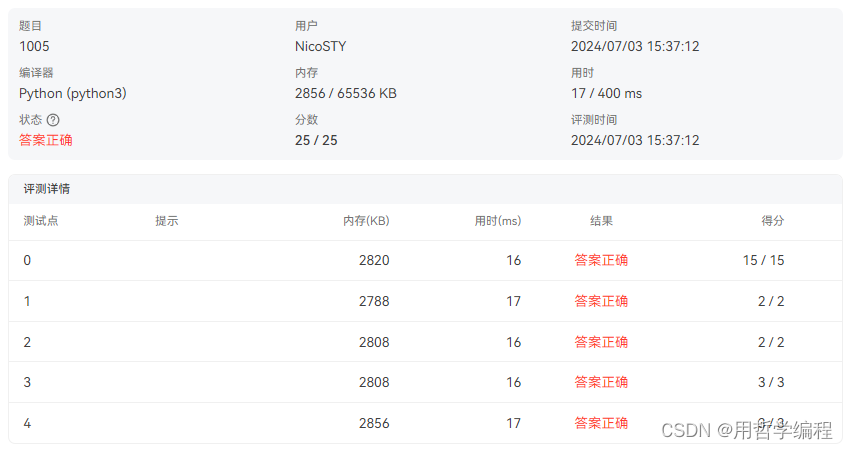nginx配置文件解析
/usr/local/nginx/conf
vim /etc/security/limits.conf
#配置生效只能重新启动
* soft nproc 65535
#能打开的进程最大数是软限制655335,65535是最大值
* hard nproc 65535
* soft nofile 65535
# 进程打开文件数的最大值65535
* hard nofile 65535
#转发和处理http请求http请求,设置代理(正代理,反向代理),缓存,定义日志格式,重定>向配置
[root@test2 conf]#vim nginx.conf
1、全局模块
worker_processes 1;
工作进程数,设置为服务器内核数的2倍(一般不超过8个,超过8个会降低性能 一般为4个 1-2个)
events {
worker_connections 1024;
}
#events模块,决定了nginx能够处理的连接数,连接数和worker_processes的数值相乘
处理进程的过程必然涉及配置文件和展示页面,也就是涉及打开文件的数量。
Linux默认打开的文件数,默认是1024
include mime.types;
#文件扩展名于文件类型的映射表。nginx能够打开的文件和支持的文件类型
default_type application/octet-stream;
#默认支持的文件类型 .html .htm .jps .js .php
#log_format main '$remote_addr - $remote_user [$time_local] "$request" '
# '$status $body_bytes_sent "$http_referer" '
# '"$http_user_agent" "$http_x_forwarded_for"';
#日志格式,默认的日志格式,记录了access.log,访问日志的格式error.log也是一样的格式
#access_log logs/access.log main;
#默认的访问日志的存放路径
sendfile on;
#支持文件发送和文件下载
#tcp_nopush on;
#默认就是异步非阻塞模式
keepalive_timeout 65;
#连接保持的时间 65秒
#gzip on;
#gzip模块,设置是否开启页面压缩
#server模块的作用:开启外部服务的模块
server {
listen 80;
#nginx的默认监听端口
server_name localhost;
#配置站点的域名
#charset koi8-r;
#网页默认字符集
#location是网页匹配的工作目录地址和支持打开页面的文件类型
location / {
root html;
#家目录 nginx默认工作目录的家目录 /usr/local/nginx/html
#alias 也是指匹配nginx的工作目录
#root是拼接,工作目录与访问路径拼接 alisa是绝对路径
index index.html index.htm;
}
#统计访问模块
# location /status {
# sdut_stattus on;
# 打开计数服务
# access_log off;
#关闭access_log日志
# }
[root@test2 conf]# #基于密码的授权进行访问控制
[root@test2 conf]# yum -y install httpd-tools
[root@test2 conf]# htpasswd -c /usr/local/nginx/passwd.db flq
New password:
Re-type new password:
Adding password for user flq
[root@test2 nginx]# chown nginx passwd.db
[root@test2 nginx]# chmod 400 passwd.db
[root@test2 nginx]# pwd
/usr/local/nginx
[root@test2 conf]# pwd
/usr/local/nginx/conf
[root@test2 conf]# vim nginx.conf
location / {
root html;
index index.html index.htm;
auth_basic "secret";
#开启用户密码验证
auth_basic_user_file /usr/local/nginx/passwd.db;
#使用指定的加密文件
}
[root@test2 conf]# #基于客户端的访问控制
[root@test2 conf]# vim nginx.conf
location / {
root html;
#添加控制规则
deny 192.168.11.138/192.168.11.139;
# deny 192.168.11.0/24;
allow all;
}
[root@test2 conf]# #基于域名的nginx主机
[root@test2 conf]# vim nginx.conf
server {
listen 80;
#nginx的默认监听端口
server_name www.xy102.com;
#配置站点的域名
charset utf-8;
access_log logs/www.xy102.com.access.log;
#新增一个域名访问
server {
listen 80;
server_name www.flq.com;
charset utf-8;
access_log logs/www.flq.com.access.log;
location / {
root /var/www/html/flq;
index index.html;
}
error_page 500 502 503 504 /50x.html;
location = /50x.html {
root html;
}
}
[root@test2 conf]# vim /etc/hosts #给ip地址映射域名
192.168.11.137 www.xy102.com www.flq.com
[root@test2 conf]# mkdir -p /var/www/html/flq
[root@test2 conf]# echo "牛啊" > /var/www/html/flq/index.html
[root@test2 conf]# curl www.xy102.com # 测试
nginx原本你的页面
[root@test2 conf]# curl www.flq.com
牛啊
[root@test2 conf]# #基于IP地址的访问
[root@test2 conf]# ifconfig ens33:0 192.168.11.199/24 #新增新的虚拟网卡
[root@test2 conf]# vim nginx.conf
#给每个服务设置其对应的ip地址
server {
listen 192.168.11.137:80;
server_name www.xy102.com;
charset utf-8;
access_log logs/www.xy102.com.access.log;
location / {
root html;
index index.html index.htm;
}
server {
listen 192.168.11.199:80;
server_name www.flq.com;
charset utf-8;
access_log logs/www.flq.com.access.log;
location / {
root /var/www/html/flq;
index index.html;
}
error_page 500 502 503 504 /50x.html;
location = /50x.html {
root html;
}
}
[root@test2 conf]# nginx -t #检查语法
nginx: the configuration file /usr/local/nginx/conf/nginx.conf syntax is ok
nginx: configuration file /usr/local/nginx/conf/nginx.conf test is successful
[root@test2 conf]# systemctl restart nginx #重启服务
#测试
[root@test2 conf]# curl 192.168.11.199:80
牛啊
[root@test2 conf]# curl 192.168.11.137:80
<!DOCTYPE html>
<html>
<head>
<title>Welcome to nginx!</title>
<style>
html { color-scheme: light dark; }
body { width:
[root@test2 conf]# #基于端口实现多个虚拟主机
[root@test2 conf]# vim nginx.conf
#给每个服务设置其对应的端口
server {
listen 192.168.11.137:80;
server_name www.xy102.com;
charset utf-8;
access_log logs/www.xy102.com.access.log;
location / {
root html;
index index.html index.htm;
}
server {
listen 192.168.11.199:80;
server_name www.flq.com;
charset utf-8;
access_log logs/www.flq.com.access.log;
location / {
root /var/www/html/flq;
index index.html;
}
error_page 500 502 503 504 /50x.html;
location = /50x.html {
root html;
}
}
[root@test2 conf]# nginx -t #检查语法
nginx: the configuration file /usr/local/nginx/conf/nginx.conf syntax is ok
nginx: configuration file /usr/local/nginx/conf/nginx.conf test is successful
[root@test2 conf]# systemctl restart nginx #重启服务
[root@test2 conf]# curl 192.168.11.199:6666
牛啊
[root@test2 conf]# curl 192.168.11.137:8888
nginx默认HTML页面
配置多个虚拟主机域名访问
[root@test2 conf]# vim nginx.conf
http {
include mime.types;
include /usr/local/nginx/conf.d/*.conf;
# 可以识别到conf.d下,只包含server模块的conf的文件
default_type application/octet-stream;
server_tokens off;
# 关闭版本号
sendfile on;
#支持文件发送和文件下载
keepalive_timeout 65;
#连接保持的时间
}
root的匹配模式 拼接
root的工作目录 访问的url /xy102
location /xy102
/opt/test1
/opt/test1/xy102/
root可以卸载server模块中,也可以在http,也可以在location中
alias匹配的nginx的工作目录,路径是绝对路径
location /xy102
alias /opt/test1/xy102/;
alias 只能写在http模块中server模块中的location模块里面。
alias匹配工作目录,不能够使用重定向功能。
总结:
1、全局模块
worker_processes 1; 指定进程数
evens 模块决定能够处理的连接数
stream 四层代理模块
http模块
转发和处理http请求,设置代理(正向代理,反向代理),缓存,定义日志格式,
重定向配置,
在http模块当中,包含:
server块 http里面可以有多个server模块
在server模块当中包含:
location模块
在server当中可以有多个location

Active connections
当前活动的连接数
server accepts handled requests:表示已经处理的连接数
三个数字,从左往右:已经处理的连接数,成功的建立连接的次数已经处理的请求数
Reading: 0 Writing: 1 Waiting: 0
reading 表示服务端正在从客户端读取请求的数据
writing 表示服务端正在把响应数据发送给客户端
waiting 表示有连接处于空闲状态,等待新的请求
nginx优化和防盗链
[root@test2 conf]# #设置页面缓存时间,主要针对动态页面,图片缓存时间
apache是自带日志分割的,按天来进行收集日志 access.log error-2024'
date -d "-1 day" "+%Y%m%d"
[root@test2 conf]# vim nginx.conf
#location ~ \.(gif|jpg|png)${
#root html;
#设置图片缓存时间
#expires 1d;
#}
[root@test2 logs]# #更改进程数已经CPU绑定
worker_processes 2;
#表示进程有2个,这里和CPU数挂钩,不绑定CPU的花,进程可能会在两个CPU之间来回切换,资
源浪费
worker_cpu_affinity 0001 0010 0100 1000;
#绑定CPU
keepalive_timeout 65;
#请求完成之后的连接保持的时间
client_header_timeout 80;
#客户端发送一个完整的请求头的超时时间,80秒之内没有发送一个完整的请求头,nginx返回>码408(request time out)
client_body_timeout 80;
#客户端和服务端建立连接之后,发送请求体的超时时间,客户端在80秒内没有发送任何内容,nginx返回>码408
gzip on;
#配置页面压缩
#gzip模块,设置是否开启页面压缩
gzip_min_length 1k;
#最小的压缩文件,效益等于1k的文件就不压缩了
gzip_buffers 4 64k;
##设置压缩的缓冲区,4个,每个缓冲区的大小64K
gzip_comp_level 6;
#压缩比例1-9,数字越小,压缩比例越小,速度越快,数字越大,压缩比例就越高,速度越慢
回收TIME_WAIT:
TIME_WAIT(不是报错,四次挥手之后会进入TIME_WAIT状态)
TIME_WAIT是tcp连接当中的一种状态,出现在四次挥手之后
处于等待状态,双方不再发送数据
time_wait所含的系统资源很小,数量比较少,完全可以忽略不计
但是太多了,就会一定的影响
连接断开(四次挥手)之后,尽快的把time_wait状态的连接进行回收
netstat -n | awk '/^tcp/' {++s[$NF]} END {for (a in s)print a s[a]}
统计当前系统连接状态
总结:
隐藏版本号
日志分割
CPU绑定
连接超时
页面压缩
页面缓存时间
time_wait状态回收*
[root@test2 conf]#vim /etc/sysctl.conf
net.ipv4.tcp_synvookies=1
#防止tcp的半连接队列溢出,可以达到服务端在收到tcp的syn(同步)的请求时能够快速响应
net.ipv4.tcp_tw_reuse=1
#允许复用time——wait状态的连接,新的连接可以直接使用time_wait的状态的端口,可以提高连接的重用率
net.ipv4.tcp_tw_recycle=1
#这个是老版本的配置,时间戳的戳记进行连接复用
net.ipv4.tcp_fin_timeout=30
##控制time_wait状态的持续时间,持续30秒,不是立即把time_wait的连接收回,而是尽可能的把time_wait状态的进行回收,没用的,空闲的,进行回收
[root@test2 conf]# sysctl -p #立即生效
防盗链
[root@test2 conf]# vim nginx.conf
location ~* \.(gif|jpg)$ {
#当识别的图片为png时不需要加入到判断中
valid_referers none blocked *.xy102.com xy102.com;
#允许xy102.com的网址访问图片,
if ( $invalid_referer ) {
rewrite ^/ http://www.xy102.com/error.png;
#如果不是xy102访问,一律跳转到盗链的提示。
}
}
[root@test2 conf]# nginx -t
nginx: the configuration file /usr/local/nginx/conf/nginx.conf syntax is ok
nginx: configuration file /usr/local/nginx/conf/nginx.conf test is successful
[root@test2 conf]# systemctl restart nginx
[root@test2 conf]# cd ..
[root@test2 nginx]# cd html/
[root@test2 html]# pwd
/usr/local/nginx/html
[root@test2 html]# vim index.html
[root@test2 html]# echo 192.168.11.137 www.xy102.com >> /etc/hosts
[root@test2 html]# echo 192.168.11.138 www.xy103.com >> /etc/hosts
[root@test2 html]# systemctl restart nginx
[root@test2 html]# vim index.html
<img src="111.png">
</body>
</html>
~
nginx
[root@test2 conf]# cd …
[root@test2 nginx]# cd html/
[root@test2 html]# pwd
/usr/local/nginx/html
[root@test2 html]# vim index.html
[root@test2 html]# echo 192.168.11.137 www.xy102.com >> /etc/hosts
[root@test2 html]# echo 192.168.11.138 www.xy103.com >> /etc/hosts
[root@test2 html]# systemctl restart nginx
[root@test2 html]# vim index.html












![[激光原理与应用-97]:激光焊接焊中检测系统系列介绍 - 1 - 什么是焊接以及传统的焊接方法](https://img-blog.csdnimg.cn/direct/cfd98a4394514dfb8780ae4eb290775b.png)






